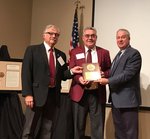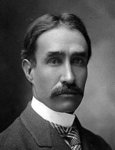Wind: 10.4 mph, S
Welcome to our new web site!
To give our readers a chance to experience all that our new website has to offer, we have made all content freely avaiable, through October 1, 2018.
During this time, print and digital subscribers will not need to log in to view our stories or e-editions.


After a two-year delay, Fabián García, a Mexican immigrant whose research at New Mexico State University helped influence agriculture nationwide, was inducted into the National Agricultural Center’s Hall of Fame in Kansas Oct. 23, becoming the first Hispanic and first New Mexican inductee.
García (1871-1948), who was originally slated to be inducted into the hall of fame in fall 2019, joins the ranks of Thomas Jefferson, George Washington and Eli Whitney, among other notable contributors to agriculture. The first ceremony was postponed due to unforeseen circumstances, and the second ceremony was rescheduled due to the COVID-19 pandemic.
New Mexico Secretary of Agriculture Jeff Witte nominated García for the distinction and attended the Oct. 23 ceremony, along with NMSU President John Floros and Rolando Flores Galarza, dean of the NMSU College of Agricultural, Consumer and Environmental Sciences.
“It is a great honor to be present and witness the induction ceremony recognizing a true agriculture icon in Dr. Fabián García,” Witte said during the ceremony. “His influence on agriculture and our cuisine continues today, over 100 years since his legacy began. Not only is he known for his agriculture legacy but for the impact he made as a humanitarian as well, a legacy made evident in the New Mexico State University dormitory that bears his name, which he funded to provide a home for those attending college. Today is a great day for all of New Mexico as we celebrate an icon that makes us proud.”
García left behind a legacy that is still felt today. He was born in Chihuahua, Mexico and became an orphan early in his life. His grandmother moved with him to the Mimbres Valley when García was only 2 years old. Once there, García’s grandmother became a domestic worker, and she later found work with the Casad family in what is now known as Old Mesilla. The family provided García with a private tutor and later sent him to what was then known as Las Cruces College.
In 1894, García became a member of the first graduating class of New Mexico College of Agriculture and Mechanical Arts, now known as NMSU. He studied for another year at Cornell University but returned to Las Cruces to receive his additional degrees.
In 1907, García married Julieta Amador, a member of a prominent Mesilla Valley family. The couple had no surviving children, and Amador died in 1920. García never remarried, preferring the environment of his beloved university.
In 1914, García was named the first director of the state Agricultural Experiment Station as well as horticulturalist. His accomplishments include producing the first reliable chile pod, which was the beginnings of what is now the Sandia pepper popular among chile lovers. He also introduced the Grano onion breed and was instrumental in planting some of the first pecan trees in the Mesilla Valley. Some of the 35 pecan tree varieties he helped plant still stand today.
García is also credited with developing modern irrigated agriculture in the state, and his horticulture publications included tests on pear, peach, grape and plum varieties, as well as trials of onion, spinach, melon and cauliflower varieties.
“It was an honor to see Fabián García get the recognition he deserves, at long last,” Floros said. “He was a leader in helping to create a sustainable and reliable food supply not just for New Mexicans, but all over the world. He also changed the lives of his students for the better. He left a great legacy here at NMSU, and it’s wonderful that he is finally receiving national acknowledgement from his peers.”
García, who sometimes faced prejudice because of his Mexican heritage, was known for helping poor Mexican-American students, often providing them rooms while they attended school. After his death, García left behind more than $85,000 to fund a campus dormitory and scholarships for poor youths with Spanish names, because, “I want to help poor boys, for I know their hardships.”
“This is a long overdue acknowledgment of the outstanding contributions to the food production by one Mexican immigrant that dedicated his life to New Mexico and U.S. agriculture,” Flores said. “Without his valuable contributions New Mexico, the U.S. and the world would have not had the advancement in plant production, and the many lives that he touched with his kindness and dedication would have not received that benefit. Fabián García is a true hero of the College of ACES, NMSU and New Mexico.”
NMSU has named a 45-acre research station after García, as well as NMSU’s faculty-senate hall, its largest dormitory and a building that sits atop a hill between Corbett Center Student Union and Breland Hall.
For more information, visit https://president.nmsu.edu/fabian-garcia/.